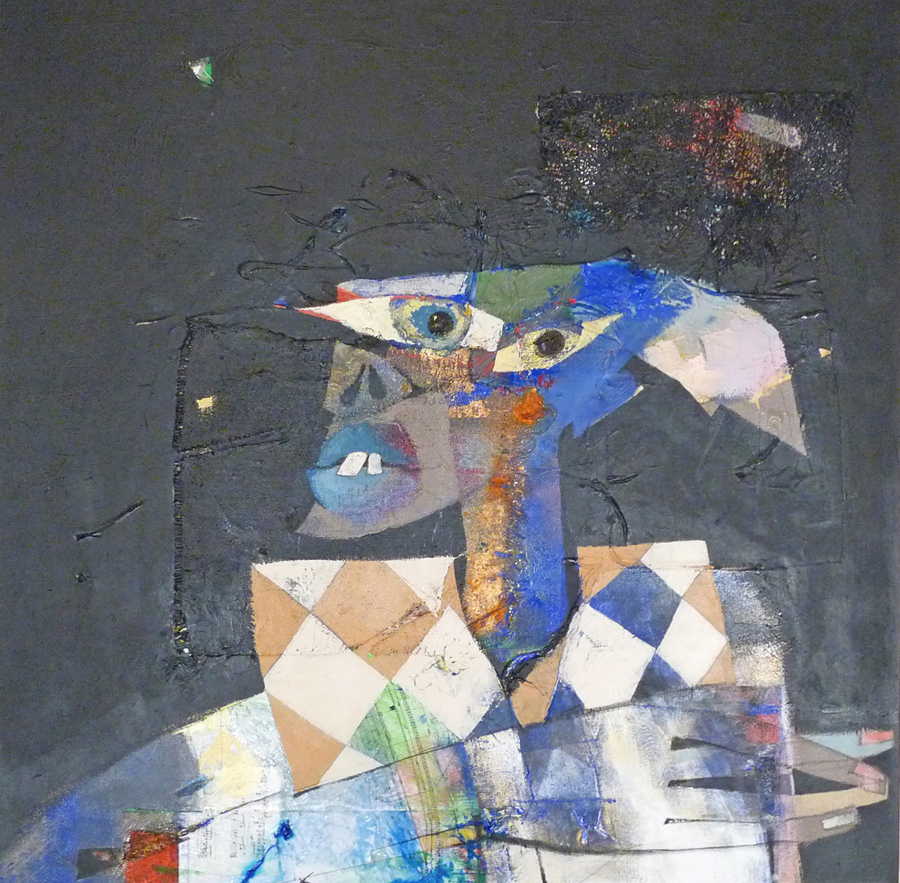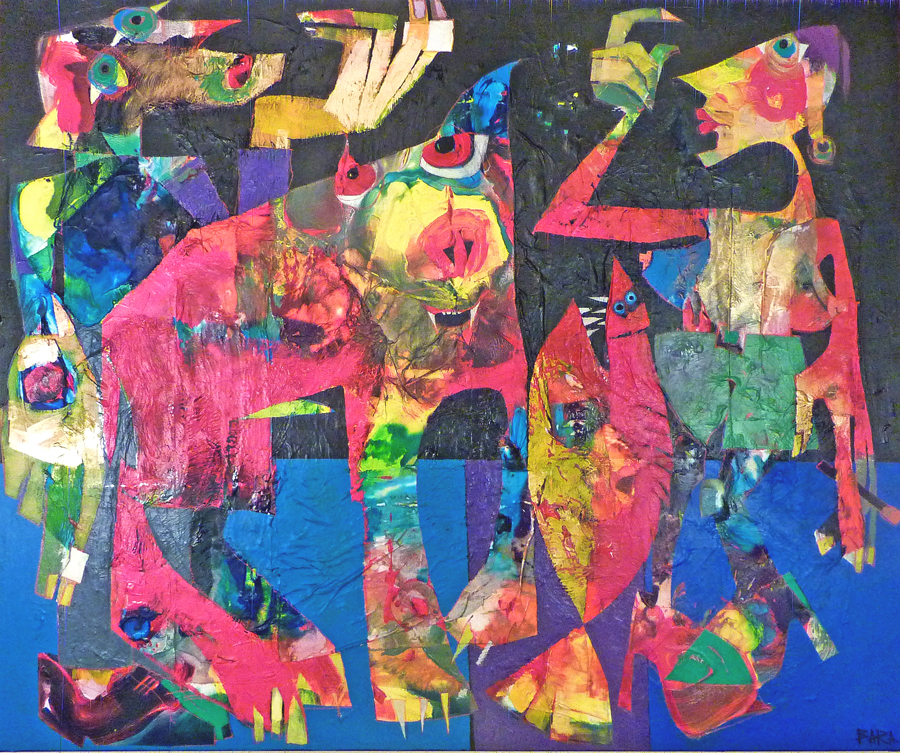Tag Archives: Mihai Bara
VEHICLE FOR DREAMING
THE CITY
THE FAITH
DIVINITY
THE ICON OF THE LIGHT
BETWEEN NIGHT AND DAY
RELIGION
MOMENTS OF THE LIGHT
THE DOCUMENTS DICTATORSHIP
KIDS
POLITICS
IL BAMBINO
THE PROMISE
THE LIAR
DEMONS OF THE CITY
FINANCIAL EXPERT
ACROBATE CRUSH
Angela di Bello
“Romanian artist Mihai Bara invites the viewer to look beyond his literal figural executions to the feelings that lie beneath. His neo-expressionist images transcend the constraints of line and form to explore the emotionality, tensions and inner experiences that lie beneath the figural façade. What results are compelling paintings full of color, texture, energy and movement. His masterful sense of composition only serves to add to the emotional depth of the paintings.
Using a mixed technique centered around acrylics on canvas combined with other media such as paper, string, textiles and sand, he infuses his works with an intensity and vigor that makes his characters come alive. Inspired by the diversity of his homeland inTransylvania, Bara infuses each figural composition with a cultural richness reflective of the greater world we share. Through his art, Bara offers up “a point of view based on a true emotion” inviting the viewer to “think more about themselves, about life, about how insignificant we are as individuals.”
Angela di Bello july 2011 New York
Maureen Flynn
“It is human nature, specifically, which preoccupies Bara most constantly, manifesting in expressively distorted figures encompassing a broad range of emotional states.
At the same time, there can often be an almost Braque-like formal stability to Bara’s compositions, as seen to particular advantage in “Clowns,” where the two zany, wildly distorted buffoons in their garish costumes, one of which contains an area of bright harlequin patterns, occupy the picture plane with the stability of floral bouquets in a still life. Here, too, is a buoyant sense of the human comedy that also figures prominently in a large triptych format called “Kids,” which corrals the anarchic energy of childhood in a particularly pleasing composition where disproportionately large, expressively gesturing hands are, again, the picture’s piece de resistance.
As a colorist, Bara is as partial as de Kooning was (particularly in his “Woman” series) to various visceral shades of pink. For pink, after all, is one particular hue of the “human clay,” which for this artist becomes a kind of Play Dough that can be stretched in all manner of inventive ways to depict a host of mortal foibles and feelings. Thus his subjects range from the tender emotions of “Il Bambino” to the tormented visage of “The Sinner,” to “The Rumour,” in which cluster heads with gabbing gobs and a gesticulating hand pointing a finger at a blushing figure in the foreground demonstrate the cruelty of gossip.
Fresh from a critically praised exhibition inRome, Mihai Bara brings his refreshingly humanistic vision toChelsea in this engaging solo show.“
Maureen Flynn july 2011 New York
Jason Plymer
“Deeply entrenched in the formal and thematic tenants of Abstract Expressionism, Romanian painter Mihai Bara seeks to translate the human condition and experience onto his canvases. Brilliant, vibrant color splashes through Bara’s works, invigorating our sense of the nature of reality and fantasy in playful enchantment. Dynamically fluid yet alluringly geometric shapes cascade throughout these paintings, speaking to the sometimes messy and problematic, yet poignantly poetic nature of human existence.
Bara explores and exploits painterly texture, yielding an exquisite richly tactile quality in his work that engages the viewer. His materials are eclectic, with latex, paper or string often mixing with traditional acrylic paints. Through this assortment of material, Bara speaks to the opulent diversities and differences alive and intermingled throughout the world. He sites his childhood hometown,Brasov, a place flush in varied languages, cultures and religions, as the source of his deep appreciation for multiplicity. It is through the plasticity of expressionism that the artist gives voice to the nuanced multitudes of human emotion.
“I would like my art to be accepted as an interesting point of view based on a true emotion,” he says. “My idea is to open a little bit the big labyrinth we have all inside.”
Mihai Bara lives and works inAndorra, a small country inSouthwestern Europe. He exhibits his work widely throughout Europe and the United States.”
www.Agora-Gallery.com/ArtistPage/Mihai_Bara.aspx
Jason Plymer july 2011 New York
Prof. Dario Evola
“Mihai Bara’s painting represents a happy and intelligent visual research with real sensibility and deepness. His work opens up the door to the viewer towards the daily circus ; his artworks are a fantastic mirror of this society, of this emotional labyrinth which finally gently invites us to…introspection. He has a unique technique and brings extraordinary details and richness of the acrylics.
Excellent show!”
Prof. Dario Evola sept 2010 Rome
Jaqueline Guenoun
“Bara offers in his exhibition a high conceptual dialogue with the audience based on the eternal reconstruction of the identity, of the feelings that lie beneath. You can almost feel his look, his critical and emotional touch, the vibration he puts on every spot of light and colour. “
Jaqueline Guenoun septembre 2008 Perpignan
Corneliu Antim
The main assets of Mihai Bara’s painting seem to be the pedantic control of his colouring instinct together with a good balance of associations and juxtapositions of the colour shades, in an apparently gestural move of the tones, creating a dominant abstract image.
Even more interesting though, are his very active and flexible poetic compositions, in which the metamorphic tensions dominate the visual impression, by evoking the magmatic whirl of matter, seeking possible forms, autonomous in their potential existence. Mihai Bara is well aware that his relationship with the viewer, irrespective of place or culture, must be sustained by concentrating his message or, ay least, by conveying his communicative intentions in a most expressive manner.
Corneliu Antim sept 2007 Bucharest


















